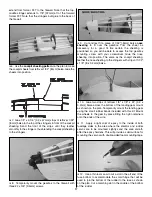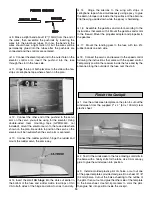
Rubber band the wing to the fuse. When ready, the assistant
should hold the model by the bottom of the fuselage behind
the wing, then raise the model high above his head and
point it
into the wind
. With the pilot standing behind the
plane, fully advance the throttle to start the motor. As soon
as the motor is at full power, the assistant should gently toss
the plane into the air at a
level
or
slightly
nose-up attitude.
Be certain the model is being launched
into
the wind. Be
immediately ready to make corrections to keep the airplane
flying straight, level and into the wind.
When the model has gained adequate flying speed under
its own power,
gently
pull the elevator stick back until the
airplane starts a gradual climb. Many beginners tend to pull
too hard causing the model to stall, so be gentle on the
elevator and don’t panic. If you do pull too hard and notice
the model losing speed, release the elevator stick and allow
the model to regain airspeed.
Continue a
gradual
climb and establish a gentle turn (away
from yourself or spectators) until the airplane reaches an
altitude of 75 to 100 feet.
The main purpose of the first few flights is to learn how the
model behaves and to adjust the trims for level flight. After
the model has climbed to a safe altitude reduce the throttle
slightly to slow the model, yet maintain altitude. The Li’l
Poke should fly well and maintain adequate airspeed at
about 1/2 to 3/4 throttle.
Adjust the elevator trim so the model flies level at the throttle
setting you are using. Adjust the aileron trim (if used) and
rudder trim to level the wings. It may take a few passes to
get the trims adjusted, but this should be your first priority
once at a comfortable altitude. Continue to fly around,
executing turns and making mental notes (or having your
assistant take notes for you) of what additional adjustments
or C.G. changes may be required to fine tune the model so
it flies the way you like.
If the Li’l Poke reaches a high enough altitude, you may
periodically cut off the motor power and glide. This may
extend the flight time by several minutes, especially if the
model flies into a rising air current.
Because the Li’l Poke flies slowly, it requires little room to
land. Begin the landing approach by flying downwind at an
altitude of approximately 20 feet [6 meters]. When the
airplane is approximately 50 to 100 feet [15 to 30 meters]
past you, reduce motor power and make the “final”
180-degree turn into the wind aligning the airplane with the
runway or landing area. Do not dive the airplane, as it will
pick up too much speed. Instead, when you reduce power,
allow the airplane to establish a gradual descent.
Concentrate on keeping it heading into the wind toward the
runway. When the plane reaches an altitude of about 4 feet
[1 meter], gently apply a little “up elevator” to level the plane,
but be careful as too much up elevator will cause it to stall.
While holding a slight amount of up elevator the airplane will
slow and descend as it loses flying speed, thus touching-
down on the runway.
Note:
Lightweight models such as the
Li’l Poke slow rapidly when motor power is cut. You will have
better control on landings if slight motor power is maintained
rather than fully cutting-off the motor.
Until you are able to accurately judge how far the Li’l Poke
can glide, it will be helpful to reserve some battery power to
run the motor so the plane can be flown back to the runway.
When speaking of small models, frequently a takeoff from
the ground is called an “ROG” (
rise off ground) takeoff.
Landings on grass will be a little rough, but doing a ROG
takeoff from grass will probably not be possible with the Li’l
Poke. If planning an ROG takeoff, find a paved surface.
After you have trimmed the Li’l Poke for flight and have become
familiar with its flight characteristics, you may execute ROG
takeoffs. With the model on the runway and pointing into the
wind, gently apply power. Initially, the plane may turn to the left
or right because it has not gained enough speed for the
controls to become effective. Do your best to get through this
brief moment and maintain a heading down the runway and
into the wind. Make corrections with the rudder to keep it rolling
straight into the wind. If the model veers too far off, cut the
throttle and try again. As the model gains speed the controls
will become effective.
After the airplane has gained adequate speed (this requires
experience to gauge), gently pull back on the elevator stick
allowing the airplane to become airborne. Establish a gentle
climb the same as when you were hand-launching.
Best of luck and happy flying!
ROG (Rise Off Ground) Takeoff
Landing
This model belongs to:
Name
Address
City, State Zip
Phone number
AMA number
Flight



































